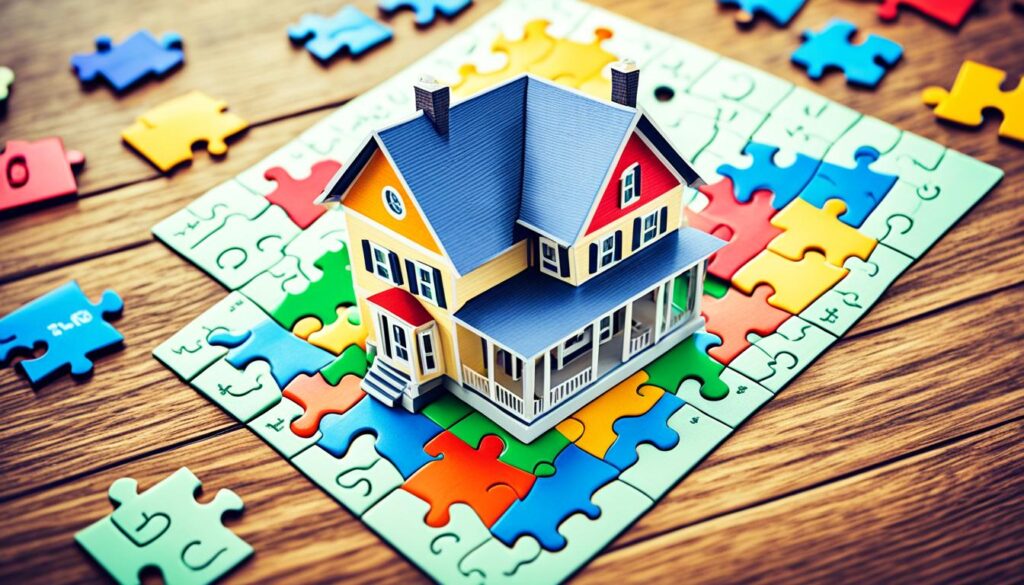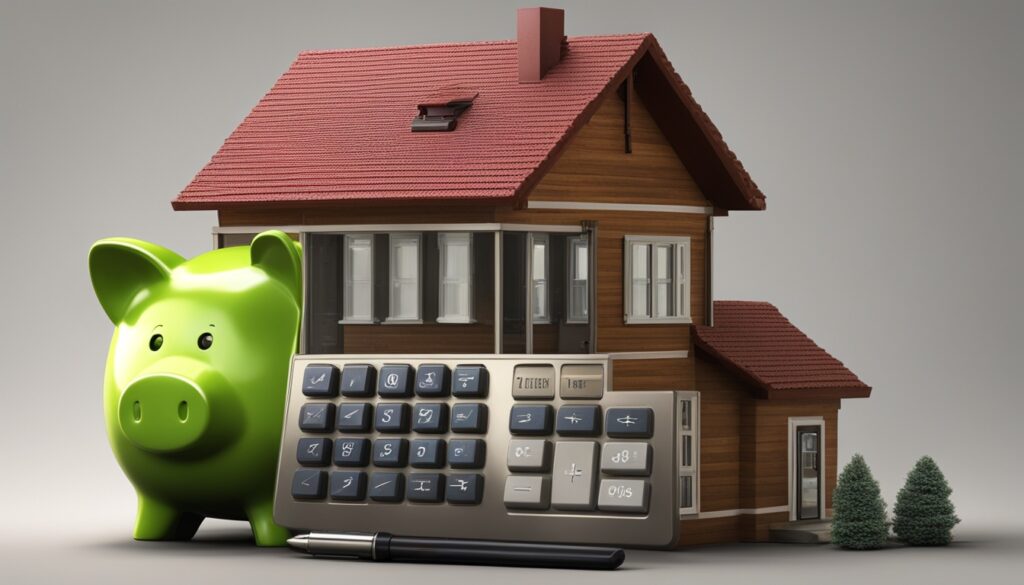A mortgage is a loan for buying a home or borrowing against a home’s value. It is key for owning a home, helping people finance their dream houses. Knowing about mortgages is vital, whether buying for the first time or refinancing.
When getting a mortgage, think about many things. You should look at the loan size, interest rate, closing costs, and more. It’s key to choose a mortgage that fits your budget, not just what you can borrow.
Also, mortgages let homeowners build equity and future wealth. The right mortgage means you can make payments you can afford and grow financially with time.
Key Takeaways:
- A mortgage is a type of loan used to buy a home or borrow money against an already owned home.
- Factors to consider when choosing a mortgage include loan size, interest rate, closing costs, APR, type of interest rate, loan term, and risky features.
- It’s important to find a mortgage that aligns with your personal financial circumstances and is affordable.
- Mortgages offer opportunities to build equity and invest in your future.
- Understanding the basics of mortgages is essential for homeownership and financial well-being.
Seven Things to Consider in a Mortgage
Consider seven key factors when looking at a mortgage. They help decide if the mortgage fits your financial needs and budget:
1. Loan Size
The loan size is the amount you borrow for a property. It’s wise to pick a size that matches your financial situation. A too-large loan could be hard to pay back each month.
2. Interest Rate and Associated Points
The interest rate is what lenders charge on your loan. It significantly affects how much your mortgage costs over time. You can pay extra at the start to lower your rate. Knowing these numbers is key to seeing if you can afford the mortgage.
3. Closing Costs
Closing costs are fees when you apply for your mortgage and at closing. These costs include appraisals, title insurance, and lawyer fees. It’s vital to know the costs to avoid budget issues at the last minute.
4. Annual Percentage Rate (APR)
The APR shows your total borrowing cost, including fees. This gives a better idea of your mortgage’s real cost than just the rate. It’s good to compare APRs to see which loan is more affordable.
5. Type of Interest Rate
You can get mortgages with either fixed or adjustable rates. A fixed rate stays the same for your whole loan, keeping your payments steady. Adjustable rates might change, causing payment shifts. Knowing the differences helps you choose what’s best for you.
6. Loan Term
The loan term is how long you have to pay back the mortgage. Short loans have higher payments but less interest over time. Long loans have lower payments but more interest. Pick what matches your budget and finances.
7. Risky Features
Watch out for mortgages with risky bits like pre-payment penalties or balloon payments. Pre-payment penalties mean extra fees if you pay off the loan early. Balloon payments are large payments at the end of your loan. Knowing these downsides can help you avoid financial surprises.
By weighing these factors carefully, you can pick a mortgage that meets your financial goals. It’s not just about getting a mortgage; it’s about choosing wisely for your situation.

Affordability Considerations in a Mortgage
Lenders decide how much you can borrow. But, it’s key for you to check your own finances. Look at income, bills, and how you save money. This helps know what mortgage you can afford.
Know your family’s total income. Add up pay, investments, and more. Then, you can find a monthly payment you can handle.
Count all your monthly bills, like utilities and debts. Subtract these from your income. This shows your affordable mortgage payment.
Think about your savings goals, like for retirement. Make sure you can still save after paying your mortgage. This is very important.
Make a full budget. List all monthly costs, including for a mortgage. This shows what you can safely spend each month.
Online tools can give an idea of what you can afford. But, every family is different. Remember to include taxes and insurance in your planning.
Here’s an example to show how monthly costs affect your choice:
| Monthly Income | $5,000 |
|---|---|
| Monthly Expenses (excluding housing) | $2,500 |
| Desired Monthly Savings | $500 |
| Estimated Property Taxes | $250 |
| Estimated Homeowner’s Insurance | $100 |
| Estimated Monthly Mortgage Payment | $1,000 |
| Estimated Private Mortgage Insurance | $150 |
Using $5,000 income and $2,500 expenses as an example, you have $2,000 left. After savings and other costs, $1,000 is left for the mortgage.
By looking at your total financial situation, you can figure out a safe mortgage amount. This approach makes home buying more certain and enjoyable.

Understanding Mortgage Costs
When thinking about a mortgage, it’s key to remember the expenses aren’t just the loan itself. You need to add homeowner’s insurance, property taxes, and private mortgage insurance to your monthly cost. Doing this will help you figure out if you can afford your mortgage.
The first cost you’ll need to think about is homeowner’s insurance. It covers your property from loss or damage by things like fire, theft, or natural disasters. The price for this coverage changes based on where your property is and its value. Talking to insurance agents will help you get estimates for your property.
Property taxes are also important. They’re used by local governments for various community services and developments. The amount you pay is set by the local tax rate and your property’s assessed value. To get an exact cost, reach out to your local tax assessors.
Lastly, there’s private mortgage insurance (PMI). You might need this if your down payment is less than 20%. PMI guards the lender in case you can’t pay back the loan. Its cost is usually part of your monthly mortgage bill. The pricing depends on your loan-to-value ratio, credit score, and mortgage amount. Lenders can tell you how much PMI will cost you.
Knowing the full monthly cost of a mortgage, which includes homeowner’s insurance, property taxes, and PMI, helps you budget for your new home correctly. This information lets you decide if you can afford your mortgage. It also makes sure you’re ready for the financial duties of homeownership.
| Expense | Explanation | How to Estimate |
|---|---|---|
| Homeowner’s Insurance | Insurance to protect your property | Contact insurance agents for estimates |
| Property Taxes | Taxes levied by local government | Consult local tax assessors for accurate estimates |
| Private Mortgage Insurance (PMI) | Insurance for loans with down payments less than 20% | Lenders can provide estimates based on your circumstances |
Key Takeaways:
- It’s vital to remember extra costs like homeowner’s insurance, property taxes, and PMI when you’re figuring out mortgage affordability.
- To get accurate estimates for these costs, talk to insurance agents, local tax assessors, and lenders.
- Understanding the total monthly payment, including these extras, helps you set a realistic budget for your new home.
Types of Mortgages
Borrowers have many mortgage options to pick from. It’s crucial to know the differences. This helps in choosing the best one. Some common types include conventional, jumbo, and government-insured loans.
1. Conventional Loans
These loans come from private lenders without government backing. They need a good credit score and a big down payment. But, they offer more flexibility in loan size and how you pay it back. This lets borrowers adjust the mortgage to fit their needs.
2. Jumbo Loans
Jumbo loans are for expensive homes that go beyond what government entities will loan. They need a large down payment and good credit. They help finance luxury homes or those in pricy areas.
3. Government-Insured Loans
These loans are supported by government agencies like the FHA and VA. They help by needing a lower down payment and being less strict on credit. They aim to help more people buy homes.
4. Fixed-Rate Mortgages
Fixed-rate mortgages keep the same interest rate the whole time. This means the monthly payment won’t change, giving borrowers peace of mind. They’re great for anyone who wants to keep their budget steady.
5. Adjustable-Rate Mortgages
Adjustable-rate mortgages have an interest rate that changes after a set time. This can be every 3, 5, 7, or 10 years. At first, these can have lower rates than fixed mortgages, making them good for those not staying long in the house.

It’s key to understand the various mortgage types. Consider whether a conventional, jumbo, or government-backed loan is best. Or, think about if a fixed-rate or adjustable-rate mortgage is right for you. By looking at your finances and goals, you can find the perfect mortgage for your needs.
Understanding How Mortgages Work
Many individuals use mortgages to buy their dream home. What is a mortgage and how does it work? Let’s look into this common way of borrowing money.
A mortgage is a loan that helps you buy a property. You don’t have to pay the full price right away. Instead, you pay back the loan plus interest over several years. This lets you own the home while making payments.
As you pay, the loan balance goes down. This process of paying off the loan is called amortization. Most of the time, your payments start by mostly covering the interest. But over time, more of what you pay goes to the loan’s actual amount.
Lenders give out mortgages because they are usually secured. The house you buy is the guarantee that you’ll pay back the loan. If you don’t pay, the lender can take the house through foreclosure.
Mortgages are good for both sides. For buyers, they make owning a home possible with a lesser upfront cost. This means you can own a home sooner and start building its value right away.
Lenders benefit by earning interest on the loan. They check if you can pay back by looking at your income, credit, and debts. If it seems you can handle the loan, they’ll likely give it to you.
“Mortgages provide borrowers with the financial flexibility to buy property and repay the loan over time, while lenders earn interest on their investment.”
But mortgages also mean you need to be responsible. Make sure you can pay back the loan without hurting your finances. Unexpected events can make it hard to keep up with payments.
Knowing how mortgages work helps us make smart choices when buying a home. It’s important to think about how it fits with your financial situation.

Mortgage Process and Steps
Getting a mortgage for your dream home involves several steps. It’s crucial to understand the process. This helps borrowers move through the stages confidently.
1. Gather and Organize Required Documents
Before you apply for a mortgage, you need to gather important documents. These show you can repay the loan. Lenders ask for bank statements, tax returns, and pay stubs. They also check your credit score.
2. Research and Compare Lenders
Researching and comparing lenders is vital. Look at interest rates, loan terms, and customer feedback. This comparison ensures you get a loan that fits your needs and budget.
3. Get Pre-Approved or Pre-Qualified
Being pre-approved or pre-qualified is a strong start. Pre-approval means the lender has reviewed your finances and offered a specific loan. Pre-qualification is based on basic info you provide. It’s not as strong as pre-approval.
“Getting pre-approved for a mortgage can show sellers that you are a serious buyer and may help you negotiate a better deal.”
4. Choose a Mortgage Option
After pre-approval, think about your mortgage options. You can choose from many loans, like conventional or government-insured ones. Look at the terms, interest rates, and down payments. Find what works best for you.
5. Submit Your Mortgage Application
Next, submit your application to your chosen lender. You’ll need to share details about your job, income, assets, and debts. They might ask more questions or for more documents later.
6. Underwriting and Approval Process
After applying, your lender starts the underwriting process. They look closely at your finances and the property’s value. You might need to provide more documents. If everything checks out, you get your loan approved.
7. Closing and Finalizing the Mortgage
When your loan is approved, it’s time for the closing. This is when you and the seller finalize the sale. You’ll sign the mortgage papers, pay the down payment, and the closing costs. Then, you officially own the house.
Knowing how the mortgage process works is key. Follow these steps to navigate through applying for a mortgage. With preparation, lender comparisons, and careful decision-making, you can get a mortgage that fits your needs and leads you to your dream home.
Mortgage Rates and Comparison
When looking at mortgages, knowing the current mortgage rates and making comparisons is key. Interest rates change a lot. They depend on the type of loan, its length, and what’s happening in the market. By shopping around and checking rates from many lenders, you can find a good deal. This helps ensure you get a loan with terms you like, including a reasonable monthly payment.
It’s good to remember that average rates shift weekly. They can also be different from lender to lender. So, keeping up to date with rates is smart. This way, you can spot great times to sign for a loan at a lower rate.
One good way to stay on top of average rates is by using trusted sources like the Federal Home Loan Mortgage Corp. They offer current rate data. This info can be a great standard to compare rates you’re offered.
Using online mortgage calculators is also wise when comparing loans. They let you see your likely monthly payments with various rates, terms, and loan amounts. It’s a great tool for understanding how different rates affect the cost of your loan.
By doing your homework with rate comparisons and calculators, you’re more likely to make a smart choice. Interest rates hugely impact your mortgage’s cost. So, choose carefully based on what works best for your budget.
Example of Mortgage Rate Comparison
| Lender | Loan Amount | Interest Rate | Monthly Payment |
|---|---|---|---|
| Ace Mortgage | $250,000 | 3.5% | $1,123 |
| Home Loan Experts | $250,000 | 3.6% | $1,135 |
| Trustworthy Bank | $250,000 | 3.8% | $1,165 |
This table shows a comparison. It’s for a $250,000 loan from three different lenders. As the interest rate goes up, your monthly payment increases. This means you pay more over the loan’s life. By comparing rates closely, you can save a lot of money.
Don’t forget, while mortgage rates are important, they’re not the only thing you should look at. Also consider closing costs, loan terms, and other factors affecting how much you’ll pay. This helps you pick a loan that’s right for you, both now and in the future.
Conclusion
Mortgages are key in owning a home. They let people buy a house by paying over time.
Choosing a mortgage means looking at how much you need to borrow, the interest, fees, and how long you’ll pay.
It’s important to know about mortgages and what buying a home costs. This helps you feel sure when dealing with mortgages. It’s wise to look at different lenders to find a good deal.
To sum up, picking a mortgage needs thought and checking a few things. A smart choice makes starting homeownership less worrisome. With the right mortgage, people can feel good about buying a home.
FAQ
What is a mortgage?
A mortgage is a loan to buy a home or take money out of its value. It’s key to owning a home. It lets people pay for their dream homes over time.
What are the seven things to consider in a mortgage?
What to think about in a mortgage are the loan size, interest rates, and points. Also, remember closing costs, APR, and fixed or adjustable rates. Don’t forget the loan term and any risky parts like pre-payment fees.
What should I consider when assessing mortgage affordability?
To check if you can afford a mortgage, think about your family’s income, spending, and savings. Don’t miss including costs for insurance, taxes, and private mortgage insurance in your budget.
What costs should I include when calculating mortgage affordability?
Besides the loan, remember to add homeowner’s insurance, taxes, and private mortgage insurance to your monthly costs. These extra costs are part of what you need to pay each month.
What are the different types of mortgages available?
There are many types of mortgages, including standard loans, larger loans, and those backed by the government. You can choose loans that keep the rate the same or ones that can change, depending on your needs.
How do mortgages work?
Mortgages let people buy homes without paying everything at once. The buyer pays back the loan and interest over many years. If they can’t pay, the lender could take the home.
What is the mortgage process and what are the steps involved?
Getting a mortgage includes applying and showing you can pay it back. Once you find a home and agree with the seller, there’s a closing meeting where you sign the final paperwork.
How do mortgage rates vary and how can I compare them?
Mortgage rates change and can be different between lenders. Compare rates from various places to find the best one. Check with different places, like the Federal Home Loan Mortgage Corp., and use online calculators to see your payments.
What is the importance of mortgages in homeownership?
Mortgages are essential for buying a home when you can’t pay all at once. It’s important to choose the right mortgage based on your loan size, interest rate, and your budget. Knowing about different mortgages and the costs can help you make a smart choice. Always look around for the best rates to save money.


















